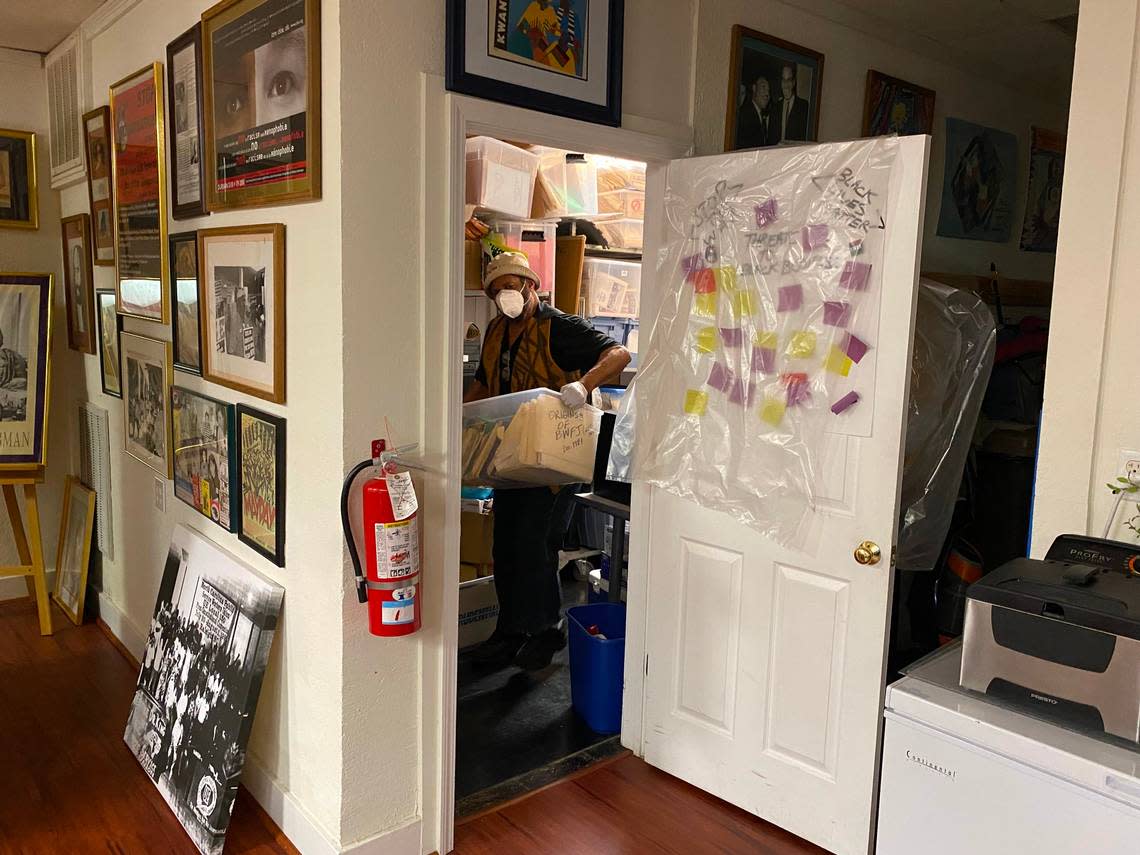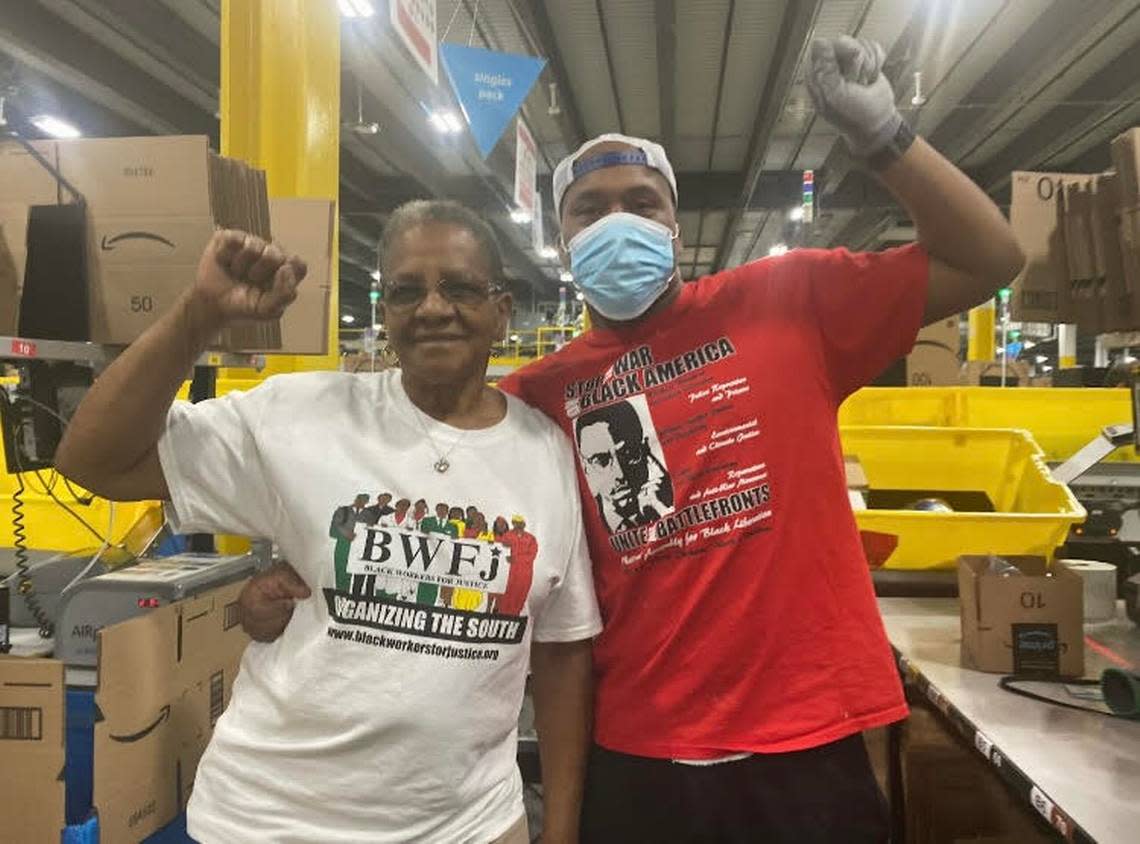Black workers fueled the NC labor movement’s past — and are guiding its future
Inside the archives, a closet crowded with binders and manila folders shelved in clear bins, Angaza Laughinghouse took a moment to strategize which bin to pull out first.
“I’m trying to figure out where to start,” he said. “I haven’t looked at some of this in ages.”
Laughinghouse, 71, was in northeast Raleigh, at the Fruit of Labor World Cultural Center, where troves of documents tell the past 40 years of labor efforts in North Carolina through the lens of Black workers.
The link is inextricable. From a Kmart boycott in Rocky Mount to a sanitation workers strike in Raleigh to an ongoing union push at an Amazon warehouse in Garner, Black workers have been central to organizing in one of the least union-friendly states.
“Black workers have often seen the labor movement as linked with the fight against racism and discrimination,” said David Zonderman, a labor historian at N.C. State. “In the past 50 years, this link between the labor movement and the civil rights movement has been very explicit in some ways.”
It’s a connection Laughinghouse hopes to pass on.
Emerging from the closet, he decided to begin at the beginning, with a bin labeled “Origins of BWFJ, Dec. 1981.” BWFJ stands for Black Workers for Justice, and over 40 years ago, Black employees in the city of Rocky Mount called for a boycott of their Kmart department store, alleging management had “unjustly fired” three workers. It was the event that inspired BWFJ, of which Laughinghouse is a cofounder.
“I’m talking about hundreds and hundreds of these struggles,” Laughinghouse said as he flipped through decades-old newspaper clippings, financial documents, and speech drafts scrawled on yellow legal pads. “We were all in our 20s, moving around everywhere to organize.”
By 1983, the group was in six counties: Wake, Wayne, Martin, Duplin, Nash and Edgecombe. Today, the group covers 10 counties.
Laughinghouse can talk at length about BWFJ, sustaining an excitable cadence.
In 1986, BWFJ led a boycott of Shoney’s restaurants in Wake, Edgecombe and Durham counties, accusing the company of discriminating on the basis of race and sex. The following year, the restaurant chain agreed to explicitly encourage the hiring and promoting of Black and women workers.

These types of gains caught the attention of the ice cream maker Ben and Jerry’s, which donated to BWFJ in the 1990s.
One of BWFJ’s proudest moments, he said, came after the 1991 fire at the Imperial Food Products plant in Hamlet, a town in the Sandhills, that killed 25 workers. It was later discovered that no safety inspector had visited the plant in its 11 years of operation.
Following the tragedy, BWFJ members spoke out at community meetings and called for accountability. The owner of the plant, a man named Emmett Roe, eventually pleaded guilty to involuntary manslaughter and went to prison.
From slavery to Smithfield
The tie between Black workers and organized labor dates back to slavery, said Ajamu A. Dillahunt, a doctoral candidate at Michigan State University and visiting fellow at East Carolina University. He is writing his dissertation on the history of BWFJ. His grandfather, also named Ajamu Dillahunt, was one of the group’s founding members.
“I think it’s important that when we talk about workers, that we talk about the foundational role Black workers had to the economy,” the younger Dillahunt said. Eastern North Carolina in particular, he pointed out, was where a large number of Black people were brought during slavery. After emancipation, many stayed to work.
Starting in the 1930s, an upstart national union called the Congress or Industrial Organizations (CIO) began organizing Black workers in the South. But the CIO faced many obstacles. Textiles and tobacco, historically the state’s largest industries, were hostile to unions, and in 1959, North Carolina banned public sector employees from collective bargaining.
That law is still in effect.
But state organizers began making in-roads during the civil rights era, Zonderman said, and the tie has carried into the 21st century.
In September 2006, around 50 employees for the City of Raleigh Solid Waste Division, most of them Black, walked off the job citing 12-hour shifts, low staffing, and unfulfilled overtime pay. In the months following this wildcat strike, the city paid out more than $40,000 to satisfy unpaid overtime claims. Many Raleigh sanitation workers today belong to UE 150, which advocates for public sector members statewide.

In 2008, a majority-Black workforce at the Smithfield Packing slaughterhouse in the Bladen County town of Tar Heel voted to join the United Food and Commercial Workers Union. With around 5,000 employees, the factory was the largest hog-slaughtering facility in the world and among the largest unionized workforces in the American South. At the time of the vote, around 60% of plant employees were Black.
Despite the Smithfield win, North Carolina remains infertile ground for labor unions. In 2022, the state again came second-to-last for union membership, ahead of only South Carolina.
Some pro-business advocates have credited this low unionization rate to the recent success North Carolina has made in adding new jobs and attracting new companies.
The next battles
In 2020, the U.S. Department of Labor released data showing Black workers in North Carolina earned on average $281 less per week than white workers.
Labor advocates believe getting more Black workers into unions can close this gap.
“(Organizing) gives the average Black and brown worker power and a platform to negotiate working conditions and wages,” said Chris Hollis, an organizer with UE 150, which has recently attempted to unionize the Darling Ingredients (formerly Valley Proteins) facility in Fayetteville.
Closer to Raleigh, Black workers at the Amazon fulfillment center in Garner are leading an organizing effort at the 4,000-person facility. In January 2022, Rev. Ryan Brown and Mary Hill formed Carolina Amazonians United for Solidarity and Empowerment, or C.A.U.S.E.
“Our organizing is a continuation of Dr. Martin Luther King Jr.’s work and those individuals in the civil rights movement,” Brown said.
Hill, who works alongside Brown in Amazon’s packing department, said most C.A.U.S.E. members are women. In 2018, the Institute for Women’s Policy Research found women of color in North Carolina earned on average $13,180 less than men.
“They see the injustices two-fold,” Hill said of her female coworkers. “This organization’s efforts hit a lot of chords on a whole lot of levels.”

C.A.U.S.E. remains in the early stages of organizing. Its leaders have held rallies and passed around petitions but have yet to hand out union authorization cards, a required step to trigger an official union election.
Only one other Amazon workforce in the country is unionized. Historically, pulling out a successful union campaign at a workforce of this size in a state like North Carolina would be a long shot. It remains an uphill battle today.
But whatever successes C.A.U.S.E. achieves in Garner, big or small, a certain group of workers will have played a pivotal role.
This story was produced with financial support from a coalition of partners led by Innovate Raleigh as part of an independent journalism fellowship program. The N&O maintains full editorial control of the work.
This Black History Month, learn the holiday’s origins and its NC history roots
Open Source
Do you enjoy Triangle tech news? Subscribe to Open Source, The News & Observer's weekly technology newsletter and look for it in your inbox every Friday morning. Sign up here.
